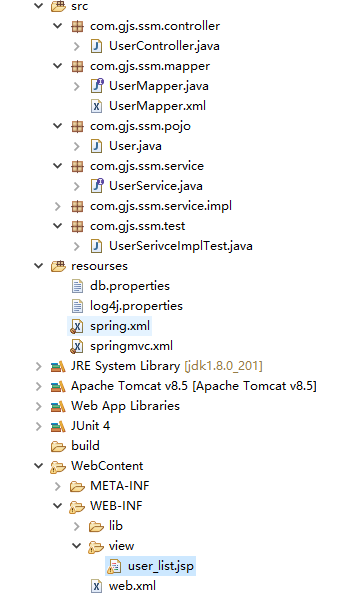SSM 框架集成
1.SSM是什么?
SSM是指目前最主流的项目架构的三大框架:
SpringMVC : spring的 Web层框架,是spring的一个模块
Spring :容器框架
MyBatis :持久层框架
2.spring与mybatis集成示例
我们集成mybatis和spring,主要是为了让mybatis用spring的事务管理
2.1 相关导入jar包
Spring依赖包:

mybatis依赖包:

MyBatis和Spring框架集成的桥梁包:
Spring自己并没有集成MyBatis框架,而是有MyBatis自己来集成,所以还需要Spring框架集成的桥梁包

数据库驱动包和连接池:


Mybatis支持的日志包log4j:

2.2 项目整体结构

2.3 Mapper层
package com.gjs.ssm.mapper; import java.util.List; import com.gjs.ssm.pojo.User; public interface UserMapper { public int insert(User user); public User selectByPrimaryKey(Integer id); public List<User> selectList(); public int delteByPrimaryKey(Integer id); }
Mapper.xml文件
<?xml version="1.0" encoding="UTF-8" ?> <!DOCTYPE mapper PUBLIC "-//mybatis.org//DTD Mapper 3.0//EN" "http://mybatis.org/dtd/mybatis-3-mapper.dtd"> <mapper namespace="com.gjs.ssm.mapper.UserMapper"> <insert id="insert" parameterType="com.gjs.ssm.pojo.User"> insert into user (name,password,age)values(#{name},#{password},#{age}) </insert> <select id="selectByPrimaryKey" parameterType="Integer" resultType="com.gjs.ssm.pojo.User"> select * from user where id = #{id} </select> <select id="selectList" resultType="com.gjs.ssm.pojo.User"> select * from user </select> <delete id="delteByPrimaryKey" parameterType="int"> delete from user where id = #{id} </delete> </mapper>
2.4 Service层
package com.gjs.ssm.service.impl; import java.util.List; import org.springframework.beans.factory.annotation.Autowired; import org.springframework.stereotype.Service; import com.gjs.ssm.mapper.UserMapper; import com.gjs.ssm.pojo.User; import com.gjs.ssm.service.UserService; @Service public class UserSerivceImpl implements UserService{ @Autowired UserMapper userMapper; @Override public int inset(User user) { return userMapper.insert(user); } @Override public User selectByPrimaryKey(Integer id) { return userMapper.selectByPrimaryKey(id); } @Override public List<User> selectList() { return userMapper.selectList(); } @Override public int delteByPrimaryKey(Integer id) { return userMapper.delteByPrimaryKey(id); } }
2.5层与层之间(Mapper和Service)spring对象的创建和依赖关系的维护(A)
之前我们Mapper对象的创建是通过sqlSession对象创建的,sqlSession对象又是SqlSessionFactory对象创建出来的,而SqlSessionFactory对象是通过读取配置文件中的相关配置创建的。
所谓的spring与mybatis集成,说白了就是把这些对象的创建都交给spring来处理。那怎么让spring自己创建这些对象呢?
spring-mybatis桥梁包中提供的org.mybatis.spring.SqlSessionFactoryBean类可以创建SqlSessionFactory对象,org.mybatis.spring.mapper.MapperScannerConfigurer类可以用来创建 Mapper接口的代理对象。所以只要在spring中配置这两个对象并注入依赖即可。具体配置如下:
spring.xml:
<?xml version="1.0" encoding="UTF-8"?> <beans xmlns="http://www.springframework.org/schema/beans" xmlns:p="http://www.springframework.org/schema/p" xmlns:context="http://www.springframework.org/schema/context" xmlns:aop="http://www.springframework.org/schema/aop" xmlns:tx="http://www.springframework.org/schema/tx" xmlns:xsi="http://www.w3.org/2001/XMLSchema-instance" xsi:schemaLocation=" http://www.springframework.org/schema/beans http://www.springframework.org/schema/beans/spring-beans.xsd http://www.springframework.org/schema/context http://www.springframework.org/schema/context/spring-context.xsd http://www.springframework.org/schema/aop http://www.springframework.org/schema/aop/spring-aop.xsd http://www.springframework.org/schema/tx http://www.springframework.org/schema/tx/spring-tx.xsd "> <!-- 开启注解包扫描 --> <context:component-scan base-package="com.gjs.ssm"/> <!-- 读取db.properties 配置文件 --> <context:property-placeholder location="classpath:db.properties"/> <!-- 配置druid连接池 --> <bean id="dataSource" class="com.alibaba.druid.pool.DruidDataSource"> <property name="driverClassName" value="${jdbc.driverClassName}"/> <property name="url" value="${jdbc.url}"/> <property name="username" value="${jdbc.username}"/> <property name="password" value="${jdbc.password}"/> <property name="maxActive" value="${jdbc.maxActive}"/> </bean> <!-- 配置SqlSessionFactoryBean对象 --> <bean name="sqlSessionFactory" class="org.mybatis.spring.SqlSessionFactoryBean"> <!-- 注入数据源 --> <property name="dataSource" ref="dataSource"/> <!-- 配置映射文件 --> <property name="mapperLocations"> <array> <value>classpath:com/gjs/ssm/mapper/*Mapper.xml</value> </array> </property> <!-- 配置包扫描的别名 --> <property name="typeAliasesPackage" value="com.gjs.ssm.pojo"/> <!-- 如果需要读取mybatis框架的配置文件mybat-config.xml可使用: <property name="configLocation" value="classpath:mybatis-config.xml"/> 不过一般不需要 --> </bean> <!-- SqlSession对象的创建只需通过sqlSessionFactory对象调用openSession()方法即可,spring会自动创建 --> <!-- 使用包扫描批量创建 Mapper接口对应的代理对象 --> <bean class="org.mybatis.spring.mapper.MapperScannerConfigurer"> <!-- 配置包扫描创建代理对象的位置 --> <property name="basePackage" value="com.gjs.ssm.mapper"/> <!-- 注入sqlSessionFactory bean的名称 --> <property name="sqlSessionFactoryBeanName" value="sqlSessionFactory"/> </bean> <!-- 配置事务管理器 --> <bean id="txManager" class="org.springframework.jdbc.datasource.DataSourceTransactionManager"> <!-- 注入数据源 --> <property name="dataSource" ref="dataSource"/> </bean> <!-- 配置事务通知 --> <tx:advice id="txAdvice" transaction-manager="txManager"> <tx:attributes> <!-- DQL --> <tx:method name="select*" read-only="true" isolation="REPEATABLE_READ" propagation="REQUIRED"/> <tx:method name="get*" read-only="true" isolation="REPEATABLE_READ" propagation="REQUIRED"/> <tx:method name="find*" read-only="true" isolation="REPEATABLE_READ" propagation="REQUIRED"/> <tx:method name="query*" read-only="true" isolation="REPEATABLE_READ" propagation="REQUIRED"/> <!-- 非DQL --> <tx:method name="*" read-only="false" isolation="REPEATABLE_READ" propagation="REQUIRED"/> </tx:attributes> </tx:advice> <!-- 使用AOP将事务切入到service层 --> <aop:config > <!-- 切入点 --> <aop:pointcut expression="execution(* com.gjs.ssm.service..*.*(..))" id="pt"/> <!-- 切面 = 切入点+通知--> <aop:advisor advice-ref="txAdvice" pointcut-ref="pt"/> <!-- Spring 负责织入 --> </aop:config> </beans>
下面这段代码是其中的关键
<!-- 配置SqlSessionFactoryBean对象 -->
<bean name="sqlSessionFactory" class="org.mybatis.spring.SqlSessionFactoryBean">
<!-- 注入数据源 -->
<property name="dataSource" ref="dataSource"/>
<!-- 配置映射文件 -->
<property name="mapperLocations">
<array>
<value>classpath:com/gjs/ssm/mapper/*Mapper.xml</value>
</array>
</property>
<!-- 配置包扫描的别名 -->
<property name="typeAliasesPackage" value="com.gjs.ssm.pojo"/>
<!--
如果需要读取mybatis框架的配置文件mybat-config.xml可使用:
<property name="configLocation" value="classpath:mybatis-config.xml"/>
不过一般不需要
-->
</bean>
<!-- SqlSession对象的创建只需通过sqlSessionFactory对象调用openSession()方法即可,spring会自动创建 -->
<!-- 使用包扫描批量创建 Mapper接口对应的代理对象 -->
<bean class="org.mybatis.spring.mapper.MapperScannerConfigurer">
<!-- 配置包扫描创建代理对象的位置 -->
<property name="basePackage" value="com.gjs.ssm.mapper"/>
<!-- 注入sqlSessionFactory bean的名称 -->
<property name="sqlSessionFactoryBeanName" value="sqlSessionFactory"/>
</bean>
2. 5 测试代码
package com.gjs.ssm.test; import java.util.List; import org.junit.Test; import org.junit.runner.RunWith; import org.springframework.beans.factory.annotation.Autowired; import org.springframework.test.context.ContextConfiguration; import org.springframework.test.context.junit4.SpringJUnit4ClassRunner; import com.gjs.ssm.pojo.User; import com.gjs.ssm.service.UserService; @RunWith(SpringJUnit4ClassRunner.class) @ContextConfiguration("classpath:spring.xml") public class UserSerivceImplTest { @Autowired private UserService userService; @Test public void testInset() { User user = new User(null, "张三", "123", 30); int row = userService.inset(user); System.out.println(row); } @Test public void testSelectByPrimaryKey() { User user = userService.selectByPrimaryKey(3); System.out.println(user); } @Test public void testSelectList() { List<User> selectList = userService.selectList(); System.out.println(selectList); } @Test public void testDelteByPrimaryKey() { int row = userService.delteByPrimaryKey(3); System.out.println(row); } }
3.SpringMVC的集成
3.1 导入相关jar包
SpringMVC依赖包:

Jstl标签库依赖包:

3.2 项目整体结构

3.3 springmvc.xml配置文件
<?xml version="1.0" encoding="UTF-8"?> <beans xmlns="http://www.springframework.org/schema/beans" xmlns:p="http://www.springframework.org/schema/p" xmlns:mvc="http://www.springframework.org/schema/mvc" xmlns:xsi="http://www.w3.org/2001/XMLSchema-instance" xsi:schemaLocation=" http://www.springframework.org/schema/beans http://www.springframework.org/schema/beans/spring-beans.xsd http://www.springframework.org/schema/mvc http://www.springframework.org/schema/mvc/spring-mvc.xsd "> <!-- 开启springMVC注解驱动 --> <mvc:annotation-driven/> </beans>
3.4 编写控制器
package com.gjs.ssm.controller; import java.util.List; import org.springframework.beans.factory.annotation.Autowired; import org.springframework.stereotype.Controller; import org.springframework.ui.Model; import org.springframework.web.bind.annotation.RequestMapping; import com.gjs.ssm.pojo.User; import com.gjs.ssm.service.UserService; @Controller @RequestMapping("/user") public class UserController { @Autowired private UserService userService; @RequestMapping("/list") public String list(Model model) { List<User> users = userService.selectList(); model.addAttribute("users", users); return "/WEB-INF/view/user_list.jsp"; } }
3.5 在web.xml配置SpringMVC的前端控制器(关键)
web.xml是整个web项目的入口,其他配置文件都需要通过web.xml直接或间接读取。所以springMVC和spring集成的关键就在于在web.xml中配置读取spring和springMVC的配置文件。
<?xml version="1.0" encoding="UTF-8"?>
<web-app xmlns:xsi="http://www.w3.org/2001/XMLSchema-instance" xmlns="http://xmlns.jcp.org/xml/ns/javaee" xsi:schemaLocation="http://xmlns.jcp.org/xml/ns/javaee http://xmlns.jcp.org/xml/ns/javaee/web-app_3_1.xsd" version="3.1">
<display-name>SSM集成</display-name>
<welcome-file-list>
<welcome-file>index.html</welcome-file>
<welcome-file>index.htm</welcome-file>
<welcome-file>index.jsp</welcome-file>
<welcome-file>default.html</welcome-file>
<welcome-file>default.htm</welcome-file>
<welcome-file>default.jsp</welcome-file>
</welcome-file-list>
<!-- 配置字符编码过滤器 -->
<filter>
<filter-name>CharacterEncodingFilter</filter-name>
<filter-class>org.springframework.web.filter.CharacterEncodingFilter</filter-class>
<init-param>
<param-name>encoding</param-name>
<param-value>UTF-8</param-value>
</init-param>
</filter>
<filter-mapping>
<filter-name>CharacterEncodingFilter</filter-name>
<url-pattern>/*</url-pattern>
</filter-mapping>
<!-- 配置前端控制器 (分发器)-->
<servlet>
<servlet-name>MVC</servlet-name>
<servlet-class>org.springframework.web.servlet.DispatcherServlet</servlet-class>
<init-param>
<!-- 读取配置文件 用通配符 *可以读取多个有相同前缀和后缀的文件-->
<param-name>contextConfigLocation</param-name>
<param-value>classpath:spring*.xml</param-value>
</init-param>
<load-on-startup>1</load-on-startup>
</servlet>
<servlet-mapping>
<servlet-name>MVC</servlet-name>
<url-pattern>*.do</url-pattern>
</servlet-mapping>
</web-app>
3.6 编写jsp页面测试
<%@ page language="java" contentType="text/html; charset=UTF-8"
pageEncoding="UTF-8"%>
<!-- 引入jstl标签库 -->
<%@ taglib uri="http://java.sun.com/jsp/jstl/core" prefix="c"%>
<!DOCTYPE html>
<html>
<head>
<meta charset="UTF-8">
<title>Insert title here</title>
</head>
<body>
<h3>用户列表</h3>
<table border="1" style="width: 500px;" cellspacing="0">
<tr>
<th>id</th>
<th>名称</th>
<th>密码</th>
<th>年龄</th>
</tr>
<c:forEach items="${users}" var="user">
<tr>
<td>${user.id}</td>
<td>${user.name}</td>
<td>${user.password}</td>
<td>${user.age}</td>
</tr>
</c:forEach>
</table>
</body>
</html>



